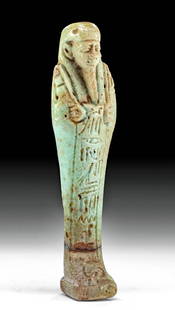
Translated Egyptian Wood Ushabti Henettawy, Ex Museum
Similar Sale History
Recommended Items





Item Details
Description
Egypt, Third Intermediate period, 21st Dynasty, ca. 1070 to 945 BCE. An impressive wooden ushabti made for the Chantress of Amun Henettawy or Henuttawi (cf. Lieblein, 2544, nos. 64 and 136) painted with a dedicatory inscription reading, "To illuminate the Osiris, Henettawy Chantress of Amun." Standing mummiform, the figure presents with a black wig and characteristically large eyes, as well as brown-painted hoes and a seed bag on the verso. The inscription runs vertically down the body. Purportedly part of the 2nd Dier El-Bahari cache of 1891, the inscription may refer to one of many Henettawys that served as a Chantress of Amun during the 21st Dynasty: possibly Henettawy B "Lady of the Two Lands," Henettawy E, or the Henettawy who was the owner of tomb MMA 59. Size: 1.25" W x 4.6" H (3.2 cm x 11.7 cm); 6.2" H (15.7 cm) on included custom stand.
Ushabti dolls are figures shaped like adult male or female mummies wearing traditional ancient Egyptian headdresses. The ancient Egyptians believed that after they died, their spirits would have to work in the "Field of Reeds" owned by the god of the underworld, Osiris. This meant doing agricultural labor - and it was required by all members of society, from workers to pharaohs. The wealthier nobility in Egyptian society were able to have ushabtis made of faience; blue faience was meant to reflect the color of the river Nile both on earth and in the afterlife. During later periods, people from the middle class also seem to have gained access to ushabti, and the materials used to create them diversified.
A similar wood ushabti from the same collection hammered $7,500 at Christie's New York as lot 56 on December 11th, 2014 (Live Auction 3403).
This piece has been owned by and exhibited in the Egyptian Museum of Antiquities in Bulaq in Cairo, Egypt, the Drexel Institute Museum (898) in Philadelphia, Pennsylvania, and the Minneapolis Institute of Art (16.265) in Minneapolis, Minnesota.
Provenance: Collection of Dr. W. Benson Harer, Los Angeles, California, USA, purchased from Superior Gallery, Los Angeles, California, USA, June 15, 1975; ex-Minneapolis Institute of Art, acquired in 1916, accession #16.731; ex-Drexel Institute Museum, Philadelphia, Pennsylvania, USA, donated in 1895; ex-Bulaq Museum, Egypt, 1894; found in second cache at Dier El-Bahari in 1891 (according to consignor)
All items legal to buy/sell under U.S. Statute covering cultural patrimony Code 2600, CHAPTER 14, and are guaranteed to be as described or your money back.
A Certificate of Authenticity will accompany all winning bids.
We ship worldwide to most countries and handle all shipping in-house for your convenience.
#180913
Ushabti dolls are figures shaped like adult male or female mummies wearing traditional ancient Egyptian headdresses. The ancient Egyptians believed that after they died, their spirits would have to work in the "Field of Reeds" owned by the god of the underworld, Osiris. This meant doing agricultural labor - and it was required by all members of society, from workers to pharaohs. The wealthier nobility in Egyptian society were able to have ushabtis made of faience; blue faience was meant to reflect the color of the river Nile both on earth and in the afterlife. During later periods, people from the middle class also seem to have gained access to ushabti, and the materials used to create them diversified.
A similar wood ushabti from the same collection hammered $7,500 at Christie's New York as lot 56 on December 11th, 2014 (Live Auction 3403).
This piece has been owned by and exhibited in the Egyptian Museum of Antiquities in Bulaq in Cairo, Egypt, the Drexel Institute Museum (898) in Philadelphia, Pennsylvania, and the Minneapolis Institute of Art (16.265) in Minneapolis, Minnesota.
Provenance: Collection of Dr. W. Benson Harer, Los Angeles, California, USA, purchased from Superior Gallery, Los Angeles, California, USA, June 15, 1975; ex-Minneapolis Institute of Art, acquired in 1916, accession #16.731; ex-Drexel Institute Museum, Philadelphia, Pennsylvania, USA, donated in 1895; ex-Bulaq Museum, Egypt, 1894; found in second cache at Dier El-Bahari in 1891 (according to consignor)
All items legal to buy/sell under U.S. Statute covering cultural patrimony Code 2600, CHAPTER 14, and are guaranteed to be as described or your money back.
A Certificate of Authenticity will accompany all winning bids.
We ship worldwide to most countries and handle all shipping in-house for your convenience.
#180913
Condition
Some small chips, as well as expected nicks and abrasions, commensurate with age. Otherwise, intact and excellent with liberal remaining pigments. Light patina and rich earthen deposits. Old inventory numbers inscribed on verso.
Buyer's Premium
- 26.5%
Translated Egyptian Wood Ushabti Henettawy, Ex Museum
Estimate $2,000 - $3,000
13 bidders are watching this item.
Shipping & Pickup Options
Item located in Louisville, CO, usSee Policy for Shipping
Local Pickup Available
Payment
Accepts seamless payments through LiveAuctioneers

Related Searches
TOP





















































